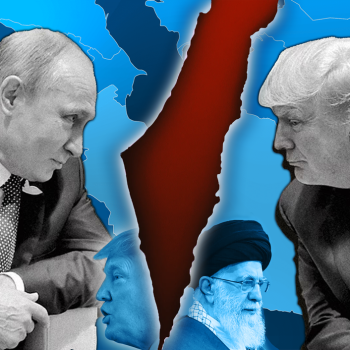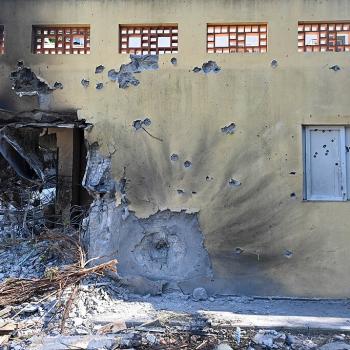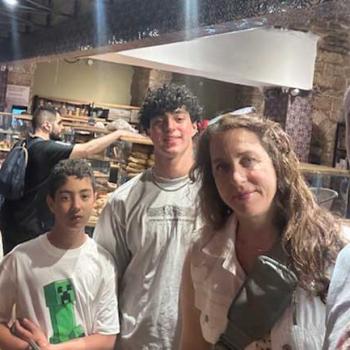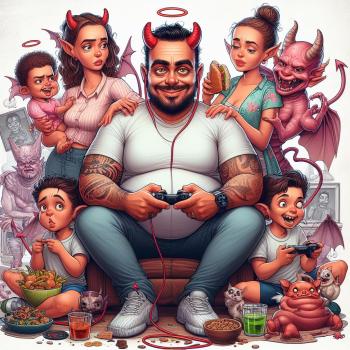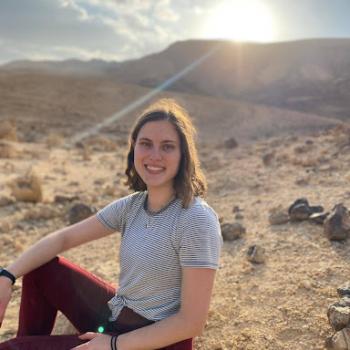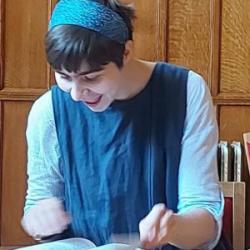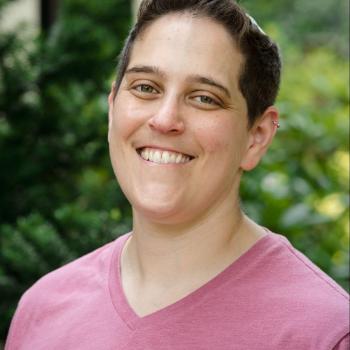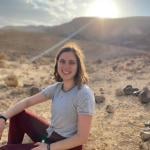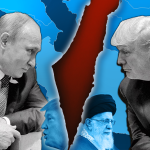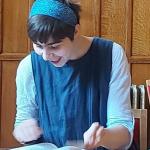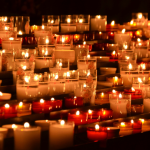Parashat Ki Tisa (Exodus 30:11-34:35)
By Rabbi Mónica Gomery, Rab`17 and Laynie Soloman
This week, revelation manifests as a rollercoaster in directionality, as Moses rises and falls from the base to the peak of Mount Sinai over and over again:
“And the Lord said to Moses: “Go, descend, for your people….” (32: 7)
“… On the next day Moses said to the people: “You have committed a grave sin. And now I will ascend to the Lord;” (32:30)
“…and Moses arose early in the morning and ascended Mount Sinai” (34:4)
“And it came to pass when Moses descended from Mount Sinai… (34:29)
The text seems to belabor the image, with various forms of the words “ascent” and “descent” appearing almost a dozen times in these chapters. At the base of the mountain is eretz, our earthly human abode, where the people stand waiting. Up the mountain is shamayim, the heavens—God’s domain, conveyed here as a sacred and removed location. As Moses ascends and descends the mountain, he is like a needle threading these two realms together, stitching a seam of connection between the earth of human dwelling and the summit of the divine.
Though the Torah repeatedly tells us about Moses’s upward and downward climbs, we learn very little about what it actually looks like on Mount Sinai when Moses receives the Torah. What is God doing up there? What is the picture of this ultimate revelation that threads the human and heavenly realms together?
In the absence of a clearer picture, the ancient rabbis do what they do best: they enter the story. A midrash in Bamidbar Rabba (19:7) invites us into the imagination of Rabbi Hanina, taught through his student Rabbi Aha:
When Moshe ascended to heaven he heard the voice of the Holy One, blessed be He, as He sat studying the section dealing with the Red Heifer, and quoting the law in the name of its author—thus R. Eliezer says [in Mishnah Para 1:1]: the broken necked calf must be a year old and the Red Heifer must be two years old.
What is God doing in this powerful revelatory moment? Sitting and studying a mishnah, of course! For Rabbi Aha and Rabbi Hanina, the picture of revelation is none other than God bent over a text, trying to understand something that is not yet clear. In the Hebrew, the midrash describes the Holy Blessed One as yoshev v’osek, sitting and engaging, working at something, fully immersed. You might recognize yourself in this position, yoshev v’osek, over words of Torah or any project, task, or text that fully occupies your attention while you’re doing it. God is a learner here, just as we so often are. In that critical moment of creative potential, in which God authors the Written Torah, we find a God who is unfinished, unsure, curious, studying. Sinai is a bet midrash.
In the midrash, the text God studies so immersively is none other than a mishnah taught in the name of Rabbi Eliezer. God is authoring parshat para adumah, the section of Torah dealing with the Red Heifer, a notoriously opaque portion of Torah law. V’omer halakha bshem omrah, and God speaks the law in the name of the one who said it: “R. Eliezer says: the broken necked calf must be a year old and the Red Heifer must be two years old” (Mishnah Parah 1:1). In an emboldened attempt to see themselves in the hidden picture of revelation, the rabbis depict not simply God studying, but God studying the Mishnah, the foundational compendium of rabbinic law. God is trying to clarify a question about what exactly a parah (a heifer) is, and looks forward in time (that’s right—God is a time traveler!) to the rabbinic tradition to help make sense of this question. Here, according to Rabbi Hanina, God is not the true author of the halakha, the law as it is known and practiced—Rabbi Eliezer is.
While for the modern reader it might feel like only a subtle move from one authoritative image of revelation to another, our rabbis make an audacious interpretive claim that can model for us what it might look like to boldly and fully enter our inherited tradition, stories, and texts. Imagine writing your own commentary on Torah, rich with your questions, your poetic interpretations, your voice and your values. Now imagine God sitting atop Mount Sinai, using your commentary as a reference guide for the creation of Torah itself.
This midrash makes a striking claim: Torah is not a manual for human beings to learn how to serve God, moving in a unilateral direction, descending to us from the top of a mountain. Rather, God learns Torah from human beings. God uses human wisdom to clarify, decode, and derive Torah, the most sacred thing.
Such an audacious moment as this one is not unique to the rabbinic imagination of Sinai. Our sages felt empowered to read their own interpretations, their lived experiences, and their embodied truths, as God’s teachers into countless stories and midrashim such as this one.
In our parsha, Moses moves up and down the mountain, blurring the boundaries between heaven and earth with each ascent and descent. Sinai becomes the commingling of the divine and the human, reflected in the transmission of a Torah that is meant to bring the two closer together. For the rabbis, what is earthly (human wisdom) becomes heavenly (Torah); what’s down comes up, what’s up comes down. A student of the Torah, Rabbi Eliezer, is imagined as God’s teacher, his wisdom embedded into the revelatory moment. For Rabbi Aha and Rabbi Hanina, Torah is not simply a partnership between God and humankind—co-imagined and co-created. Rather, God needs our Torah, God learns from our Torah, God is captivated by our Torah.
As teachers and as faculty members at SVARA and beyond, it is our hope that students learn just how radically empowering our tradition is, how it trusts and longs for human wisdom, the wisdom of our experiences coupled with our deep immersion in text. God is osek in our Torah—fascinated, captivated, and growing alongside us as we grow. God expands and illuminates Torah by the light of our learning and teaching. May we be as lucid and as daring as our sages, and remember that we all have something invaluable and transformative to teach God about the world.
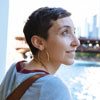 Rabbi Mónica Gomery is a lover of questions, community, language and song. She was honored to receive ordination from the Rabbinical School of Hebrew College in 2017 and is the new Associate Director of SVARA: A Traditionally Radical Yeshiva, where she builds queer Jewish community and teaches Talmud. She is also a founder and co-organizer of Let My People Sing! transformative Jewish singing retreats.
Rabbi Mónica Gomery is a lover of questions, community, language and song. She was honored to receive ordination from the Rabbinical School of Hebrew College in 2017 and is the new Associate Director of SVARA: A Traditionally Radical Yeshiva, where she builds queer Jewish community and teaches Talmud. She is also a founder and co-organizer of Let My People Sing! transformative Jewish singing retreats.
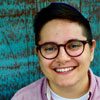 Laynie Soloman is a faculty member and Director of Educational Initiatives at SVARA: A Traditionally Radical Yeshiva. They are pursuing a Dual M.A. in Talmud/Rabbinics & Jewish Education from the Jewish Theological Seminary in New York City, and serve as a junior faculty member at Yeshivat Hadar. They are passionate about facilitating empowering experiences of Jewish learning that uplift the piously irreverent, queer, and subversive spirit of rabbinic text and theology.
Laynie Soloman is a faculty member and Director of Educational Initiatives at SVARA: A Traditionally Radical Yeshiva. They are pursuing a Dual M.A. in Talmud/Rabbinics & Jewish Education from the Jewish Theological Seminary in New York City, and serve as a junior faculty member at Yeshivat Hadar. They are passionate about facilitating empowering experiences of Jewish learning that uplift the piously irreverent, queer, and subversive spirit of rabbinic text and theology.
Interested in a possible career in the rabbinate? Read Rabbi Dan Judson’s article “Jewish Lessons on Meaningful Work.“ Rabbi Judson is Dean of the Rabbinical School of Hebrew College. He has a PhD in Jewish history from Brandeis University.



